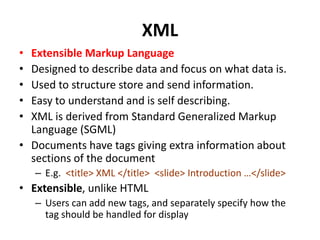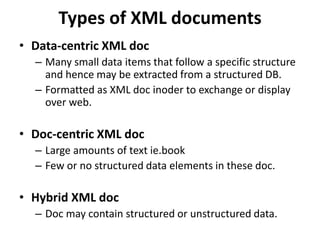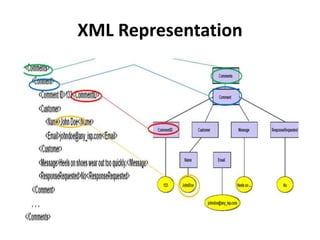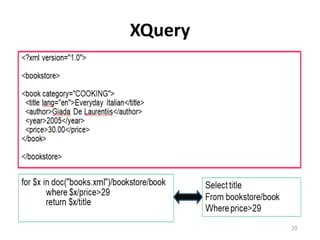XML-Extensible Markup Language
- 2. XML • Extensible Markup Language • Designed to describe data and focus on what data is. • Used to structure store and send information. • Easy to understand and is self describing. • XML is derived from Standard Generalized Markup Language (SGML) • Documents have tags giving extra information about sections of the document – E.g. <title> XML </title> <slide> Introduction …</slide> • Extensible, unlike HTML – Users can add new tags, and separately specify how the tag should be handled for display
- 3. Types of XML databases There are two major types of XML databases: • XML-enabled: These map all XML to a traditional database, accepting XML as input and rendering XML as output. • Native XML (NXD): The internal model depends on XML and uses XML documents as the fundamental unit of storage.
- 4. XML document rules • A “well formed” XML doc has to have correct XML syntax and they are : – Must start with a n XML declaration to indicate the version of XML being used as well as other relevant attributes. – Must have a root element. – Must have a closing tag. – XML tags are case sensitive. – XML elements must be properly nested. – XML attribute values must be quoted.
- 5. <?xml version = "1.0"?> Structure of XML Data <library xmlns:mevlana=“http://mevlana.edu.tr”> <book id="bk101"> <author>Gambardella, Matthew</author> <title>XML Developer's Guide</title> <genre>Computer</genre> <price>44.95</price> <publish_date>2000-10-01</publish_date> </book> </library> <!-- comments --> 5 Start tag End tag Element Attribute Namespace Comments tag XML Document Node
- 6. • Hierarchical Data Model (Tree Structure). • Basic object in XML is XML document. • 2 main structuring concepts are used to construct an XML doc – Elements : start tag and end tag. – Attributes : additional info to describe elements. • In the tree representation – Internal node : complex elements. – Leaf node : simple elements.
- 7. Types of XML documents • Data-centric XML doc – Many small data items that follow a specific structure and hence may be extracted from a structured DB. – Formatted as XML doc inoder to exchange or display over web. • Doc-centric XML doc – Large amounts of text ie.book – Few or no structured data elements in these doc. • Hybrid XML doc – Doc may contain structured or unstructured data.
- 8. XML vs. Relational Database XML Database • XML data is hierarchical • XML data is self-describing • XML data has inherent ordering • An XML database contains collections Relational Database • relational data is represented in a model of logical relationships • relational data is not self- describing • Relational data does not have inherent ordering • A relational database contains tables
- 9. XML vs. Relational Database
- 11. XML Document Schema • Database schemas constrain what information can be stored, and the data types of stored values • XML documents are not required to have an associated schema • Schemas are very important for XML data exchange • Two mechanisms for specifying XML schema –Document Type Definition (DTD) –XML Schema Definition (XSD)
- 12. Document Type Definition • DTD constraints structure of XML data – What elements can occur – What attributes can/must an element have – What subelements can/must occur inside each element, and how many times. • Limitations – Data types in DTD are not general – DTD has its own special syntax and thus require special processors.
- 14. XML Schema Definition • XML Schema is a more sophisticated schema language which addresses the drawbacks of DTDs. Supports Different data types. • XML Schema is itself specified in XML syntax, unlike DTDs • XML Schema is integrated with namespaces • XML Schema is significantly more complicated than DTDs
- 15. Querying XML Data • There are several languages used to access XML data from XML Documents, some are: – XPath – Xquery (most popular)
- 16. XPath
- 17. XQuery • XQuery is a general purpose query language for XML data • XQuery is built on XPath expressions • XQuery is derived from the quilt query language, which itself borrows from SQL • XQuery is supported by all database engines (IBM, Oracle, Microsoft, etc.) • XQuery uses FLOWR (for, let, where, order by , result) – for SQL from – where SQL where – order by SQL order by – result SQL select – let allows temporary variables
- 18. XQuery
- 19. Benefits of XML • XML doc is text based – Takes less space can be transmitted efficiently • One XML doc can be displayed differently on different media. • XML doc parts can be reused. • Easy to understand.
- 20. Drawbacks of XML • Case sensitive in nature • XML syntax are redundant or large to binary representation of the same data. • Users must predefine their own tags • Linking between XML docs requires xlink which is complex compared to hyperlinks.




















